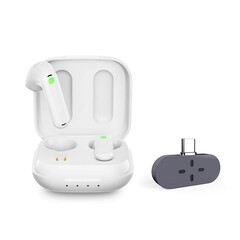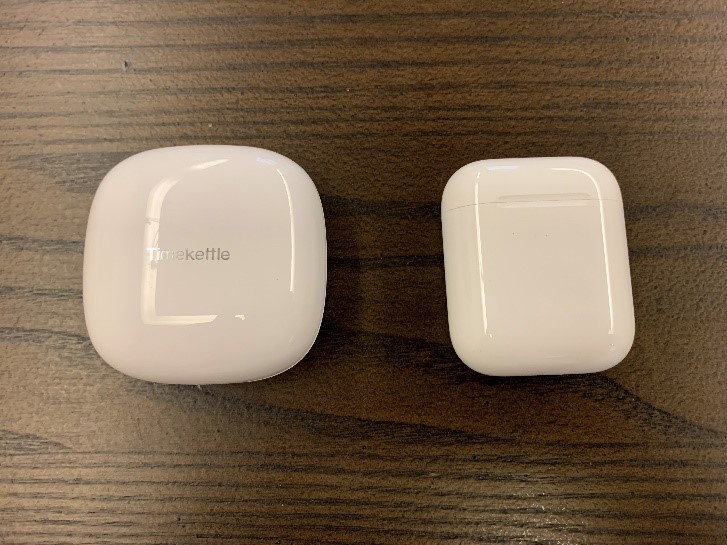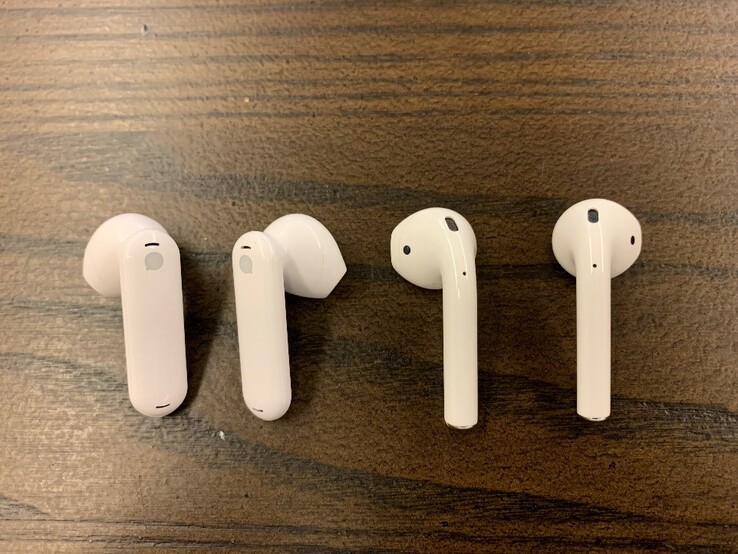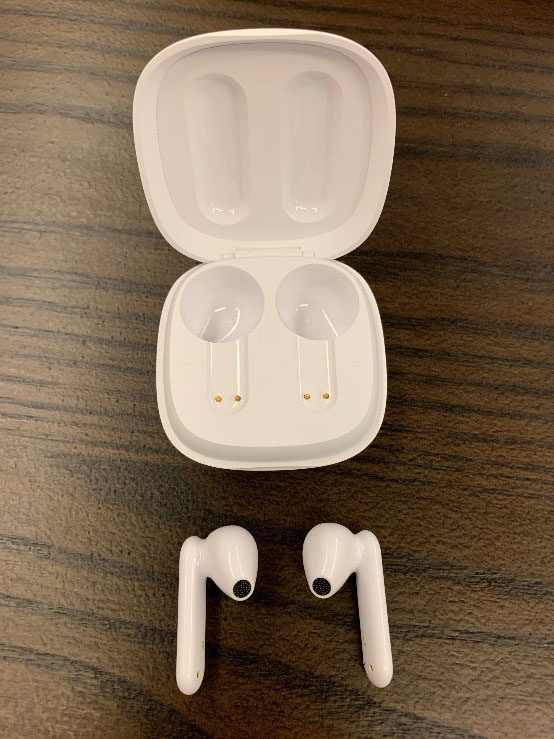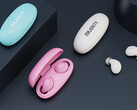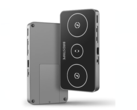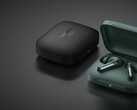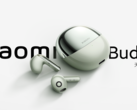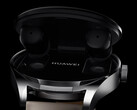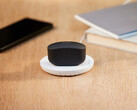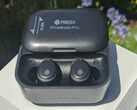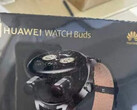The Timekettle WT2 Edge Translator Earbuds are the latest bi-directional, simultaneous translation product from Timekettle. Their translator earbuds support simultaneous interpretation of over 40 different languages in 93 accents as well as featuring offline translation for 8 languages (English, Spanish, German, French, Chinese, Japanese, Russian, and Korean). The Timekettle WT2 Edge uses Timekettle’s HybridComm technology to provide faster, cleaner, and more accurate cross-language translation. The idea for the WT2 came from Douglas Adam’s novel “The Hitchhiker’s Guide to the Galaxy”, where the characters stuck a small fish called a “Babel Fish” into their ears to instantly translate any language in the galaxy. The first generation of the WT2 was introduced in 2017 as the first ear-to-ear wearable translator. In 2021, the second generation, the WT2 Edge, was launched promising 95% accuracy, less than 3 second translation speed, and a 12-hour battery life for $299.99 USD.
The real time translating space has begun to take off recently, with advancements in Artificial Intelligence and Machine Learning making it possible to have our conversations instantly translated. Companies such as Google and Meta both have their own translating apps that take conversations from a user and run it through their translating algorithms. The drawback to this approach is that these platforms lack the ability to do instantaneous translations between multiple people. And since these translators are primarily app driven, there is no specialized technology (such as microphones or sound filters) to supplement the translation process.
The Timekettle WT2 Edge Translator Earbuds comes in two color options (black or white) in a sleek, small compact package that is just barely bigger than an Apple AirPod case. The earbuds can only be used with the Timekettle App for translating and cannot be used for music or phone calls. The carrying case doubles as a charger and can be easily tossed into a briefcase or purse to take along anytime you feel like a translator may be needed. The earbuds can be fully charged over USB-C in 90 minutes. Timekettle advertises a 12-hour battery life with the charging case and 3 hours of continuous translation with the earbuds. However, our testing showed that the earbuds charge was not as reliable, sometimes only getting as much as 2 hours before they needed to be recharged.
The earbuds themselves are about the same size as Apple AirPods. The earpiece has a snug fit and you can hardly feel any weight even though the stems look a bit bulky. If you are comfortable with the size and shape of AirPods, then you should have no problem adjusting to the Timekettle WT2 Earbuds. The touch sensitive area at the top of the stem features a small indicator light to warn the user about battery levels and connectivity. Timekettle also includes two pairs of silicon covers for the ear tips.
Our testing consisted of translating between Mandarin and English. The translations were very accurate for basic conversations, such as plans for the day or questions about food and everyday topics. However, the translation accuracy was noticeably lower when we switched to a very specific topic such as financial/tax planning or medical and pharmaceutical questions. When using the WT2 Edge, we discovered that the speed of talking was one of the biggest (if not the biggest) factors contributing to the accuracy of the translations. Although the WT2 Edge can provide translations in less than three seconds, to get the most accurate translation both users must be cognizant of how fast they are talking and be prepared to slow down to allow the Timekettle App to properly pick up the sentences for translation.
The WT2 Edge features “Smart Noise Reduction”, but in our testing the earbuds were not very successful at filtering out background noise. Loud noises from places such as a crowded restaurant will still be heard but the earbuds were still able to pick up the users’ voices and perform translations. Performance was generally better in quieter and less hectic areas.
Timekettle has 15 servers worldwide to drive its translation software. Translation latency will depend on the user’s location to one of these 15 servers. The WT2 Edge also has an offline translation mode for eight languages. In order to use this mode, the user has to buy and download additional language packs onto their smartphone. Each language pack costs 5 “Fish” points (5 fish = $9.99 USD). The $299 base version of the WT2 Edge does not come with any “Fish” points, while the $350 “offline” version includes 30 Fish points. While the offline language packs are more of a convenience and definitely not a necessity, at this price point Timekettle could have easily included one or more packs for free instead of directing users to its online “Fish” store to make purchases.
The WT2 Edge works by using Bluetooth to connect to the Timekettle App on your smartphone. Removing the earbuds from the case will start the connection process. From there, you need to open the Timekettle App and select the Timekettle product to sync. The product can be put into four different translation modes (Simultaneous, Touch, Speaker, Listen) depending on the translation needs of the user. The App automatically saves a translation history on your phone for later viewing.
Simultaneous Mode (Simul Mode) is the much flaunted hands-free, bi-directional simultaneous interpretation that Timekettle is working to perfect. In this mode, each person wears an earbud and speaks in their own language. Timekettle translates what one person is saying and transmits it into the earbud of the other person. This mode is primarily for business scenarios or other situations in which a long, in-depth conversation will need to be continuously translated for a long time.
In this mode, both users can expect a translation within 3 seconds so they must be prepared to pause after they are done talking. While Simul Mode is very useful, there is an “unnatural” feel to a conversation when both people must intermittently pause. We found this mode to be most useful for chats among friends and family of different languages, but not necessarily for a business negotiation or an hour-long conversation.
Touch Mode allows the user to control what the WT2 Edge picks up and translates. In this mode, you tap the earbud, speak, and then tap again to finish. Timekettle then immediately processes the translation and plays it into the earbuds of the listeners. This mode is most useful in noisy environments, or situations in which there are multiple people using the WT2 Edge (such as a large business meeting.)
Although the touch mode requires the user to manually start and stop the translation process, we found it the most intuitive, as both users have a clear indication of when the other is done talking. It is also calming to know that the earbuds are not continuously translating and that you can choose when to start and stop the translation process.
Speaker Mode allows the user to simply wear an earbud and use their smartphone for translating. Speaking into the earbud will allow the Timekettle App to translate your message and play it back on your smartphone for the other person to hear. This mode is intended for quick questions and exchanges, such as ordering food or asking for directions.
Speaker Mode is similar to other translation Apps and relies on one or more people to speak into your smartphone. It is most ideal for someone who may be travelling in another country and having a quick conversation.
Listen Mode uses the smartphone to continuously pick up and translate sentences into the earbud. This is a one-way translation mode intended for speeches and teaching.
We found Listen mode to be useful for a variety of applications, such as learning a new cooking recipe or attending a conference. Here, the speed of the translation is not as big of a factor and the App also saves the entire script for review. One thing to note is that in listen mode the speaker will have to be very close your smartphone in order for the App to pick up the sentences for translation.
In conclusion, Timekettle’s WT2 Edge Translator Earbuds are a great translation tool with spot on accuracy in daily conversation and very user friendly, with four different modes to allow users to fine tune their translating experience. The Timekettle requirement to require users to buy additional languages for offline support is a bit of a miss, but with internet access readily available all over the world one can easily ignore offline support and still get all the benefits of the Timekettle’s translation services. At $299, the Timekettle earbuds are useful for someone who regularly finds themselves in need of translating long conversations but perhaps not for a world traveler who may need a quick translation when ordering coffee or looking for the nearest subway.


 Deutsch
Deutsch English
English Español
Español Français
Français Italiano
Italiano Nederlands
Nederlands Polski
Polski Português
Português Русский
Русский Türkçe
Türkçe Svenska
Svenska Chinese
Chinese Magyar
Magyar